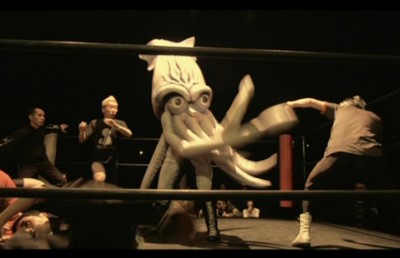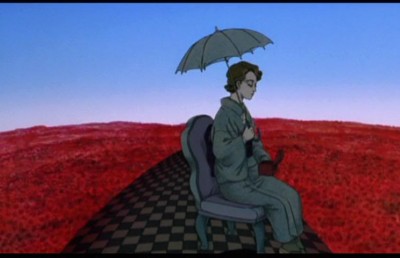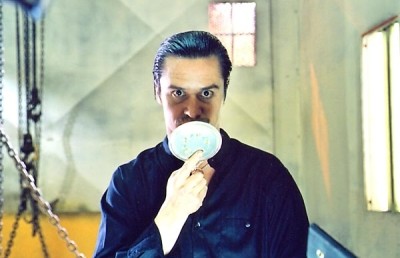Tomoko Matsunashi: The Way of the Interview
Japanese Feminist Comedy
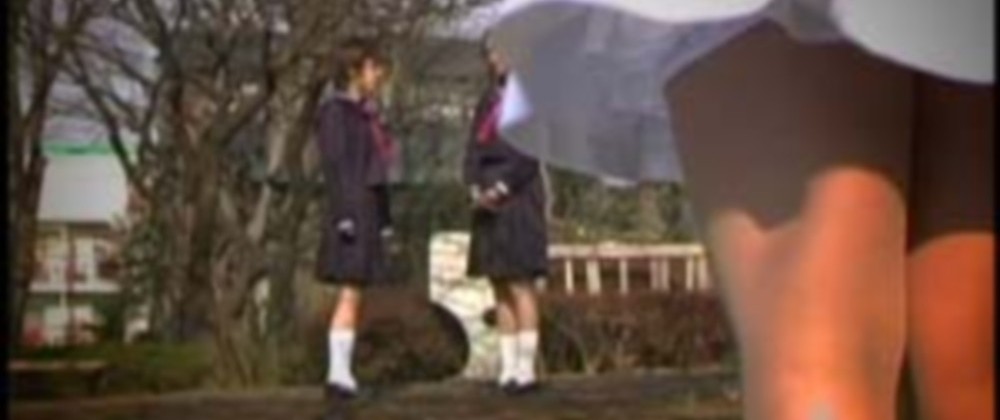
This interview with Tomoko Matsunashi director of The Way of the Director, was translated by Tomoko Okabe, with Michiko Higuchi, who programmed the film for the Fantasia film festival; conducted by Peter Rist in the Mel Hoppenheim School of Cinema, Concordia University, Montreal on July 20, 2005:
The Way of the Director (2005), 94 mins., DVCam, colour, stereo
Synopsis:
Kitagawa and Saito, both aspiring to be movie directors, win awards at a movie festival, and strive, but fail to become professional film directors. With support from a small theatre manager named Araki, Saito manages to direct and star in her own movies. She wears a strange costume and calls herself “Strawberry,” and gradually gains popularity in the independent movie scene. On the other hand, Kitagawa does not do well even though he has absolute confidence in himself. Soon the relationship with his next heroine, Sakurako (played by Tomoko Matsunashi) is over. Not long after the break-up with Sakurako, he runs into his old acquaintance, Yamamoto, who persuades Kitagawa to become a porno movie director. Kitagawa becomes a popular director in the “pink” industry, but, he never gives up on his desire to become a “real” film director.
One day, Yamamoto takes Kitagawa to the premiere of Saito’s big movie, where Kitagawa and Saito meet for the first time in ten years. Araki gives Kitagawa the chance to direct a legitimate film, which would be shown in his theatre. Kitagawa gets the idea of filming a trek across Hokkaido in the northernmost part of Japan in mid-winter, with Saito. Things don’t go well: Saito dies and Kitagawa eats her flesh in order to survive, and he eventually succumbs to the elements. But Yamamoto is able to retrieve Kitagawa’s sensational footage and turns it into a hit film.

Offscreen: I think that your film is “original, truthful and very funny,” and what really amazed me about the film is how “universal” the subject was so that anybody who knows anything about people who work on films can understand some of the issues. First of all I wonder if you could tell me a bit about your own background; for example, if you went to film school or not. I know that in the first part of the film we see your character win an award, so if you talk about the process of that competition for young filmmakers, just to give us some background…
Tomoko Matsunashi: I was always interested in the theatre, and since a very early age, when I was in elementary school I wanted to be an actor; that was my dream. So, I entered Wasada University, and although I didn’t study theatre formally, I signed up for commerce/business, and a group of us formed an extra-curricular drama group. In fact this university is quite famous for such independent theatre activity, it is probably the best in Japan.
When I was at university, and involving myself in the independent theatre activity, I discovered that several members of the circle were also involved in film, and had formed a film circle. When I graduated the group was disbanded, because the members couldn’t agree on which direction to pursue. But later, I managed to get a part in a film directed by one of the former group members. I played the leading role in another one of these independent films, which won the audience award at the Pia Film Festival, and then I got the idea of working with other ex-members of the circle. Now that the numbers were smaller it would have been much more difficult to put on a theatrical play, so, we got the idea that making films would be easier to do with the smaller number of participants. But the person who had directed the film which had won the award quit because he didn’t think that the proposed project was funny, and he was no longer interested in collaborating with the remaining members of the circle, so I decided, OK, its my turn, and that’s how I started to make films.
Offscreen: So, you had no actual, formal training in film, at all?
TM: That is correct. I had no formal film education, but, once I was acting in independent movies—and I took many roles, I did many things, because there were only a few members—and, then I realized, ah, I can do that, I can work behind the camera as well as in front of it. I can shoot and direct films, too.

Offscreen: So then I understand that you made a film before The Way of the Director, which was submitted to the Fantasia festival, and this was your first feature film, was it? It is quite remarkable to me that you have been able to make such an accomplished work with no training in cinema. Can you talk more about how you got to this point?
TM: The movie I mentioned which I was in was only 30 minutes in length. My first film as a director (To Be or Not to Be, 1995) was also only 30 minutes in length, but it won the Special Jury Prize at the Yubari Fantastic Film Festival in 1996. I also wrote the scenario and acted in it. I did everything.
Offscreen: That is interesting because I was thinking that, based on what I know of the Yubari festival—although I’ve never been there— The Way of the Director would probably be a very good entry for this festival.
TM: Actually, I have made a lot of films [see filmography, below].
Offscreen: Perhaps Michiko Higuchi if you could talk about your involvement in making the connection between Fantasia and Tomoko Matsunashi, and bringing her here to Montreal, as well?
MH: Last year, the Yubari Fantastic Film festival showed her previous film, and Pierre Corbeil [the director of Fantasia] wanted a contact list for movies that were shown there. So I saw TM’s The Poison Woman, Matilda —aka, “Bitch Matilda”—, and therefore I wanted to contact her about showing this work at Fantasia. That is how it started.
The first part of this film was made in 1998, and after a long time the second part —“Bitch Matilda 2”— was made. The two parts should be shown together, it doesn’t make sense to do otherwise, but if the festival showed it like this, it would have been over two hours and this would be too long, and that’s the reason why we elected not to show this work. When we explained this to Ms Matsunashi she recommended her latest work to us, and we were able to include The Way of the Director as a late addition to Fantasia.
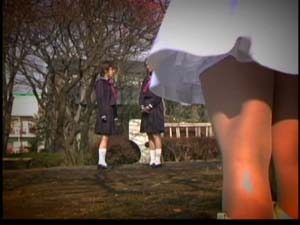
Offscreen: The narrative construction of The Way of the Director is very precise, and you also said in your speech yesterday that you storyboarded the film which is interesting because that is a very visual approach that wouldn’t normally come from a theatrical or literary background, and I was also struck by the visual style—the quality, the texture, because it is digital is not necessarily of great quality—but, I thought that the staging of the material was very interesting especially in relation to the central male character, Kitagawa who as you said yesterday was based on your ex-boyfriend, because he is so hysterical, and often he is in the extreme-foreground of the shot, and you are using deep focus… It is such an exaggerated style of acting, which is made even more exaggerated by the visual style, using a wide-angle lens. So I was wondering if this usage of the wide-angle lens was associated with his character? Could you talk a bit about your visual approach…? I’m sorry. I have asked too much here…
TM: I appreciate your comments very much, but, I have made ten movies over the last ten years and for every single one I have been criticised, very harshly at times, by the audience. I feel I have learned so much and improved so much with each film, but I still don’t feel confident about my technique. I am still not satisfied that I am accomplished on this level.Offscreen: Well, you can feel more confident because, like I say, there is obviously a lot of thinking gone into the style, for example, the opening sequence of “Strawberry” is like an action film, and it is very different from the rest of the film, and, when you are representing the style of the “genius” filmmaker (Kitagawa) you film in a documentary style, which is appropriate, here. So you employ different styles at different times. I hope that you can feel more confident about this. And, it could be that people are complaining about your filmmaking because you are a woman. [much laughter]

TM: Thank you.
Offscreen: On my initial comment regarding the “originality” of your work, I want to say that there are a lot of films out there about filmmaking, even comedies, but yours is very original because it is the first film like this, that I have seen, which has been directed by a woman [ed. Asia Argento’s Scarlet Diva, 2000, also exposes the cruder, patriarchal side of the film industry]. For me, the film works as an exposé of men in relation to film in the same way that men are related to women. Since this is a world premiere, I suspect that a lot of men will be upset by your original treatment of that. So, are you ready to defend yourself in terms of representing men in the film industry? The bottom line is that I think that the greatness of the work is in your treatment of film and men.
TM: All of my previous movies were very revealing of men, also, so I’ve had a lot of criticism in this way already. And all of my films are based on my own previous experiences with my ex-boyfriends, and since I haven’t been around any really wonderful men, I can hardly portray them otherwise…
Offscreen: Through my experience of teaching film students over the years, I have become more and more suspicious of why men want to get into film. So your presentation of the “genius” character—he’s a character who believes he is going to be a great filmmaker and that’s why he makes films—but I wonder if there might be another approach to this: I’m asking the question, do you think that men choose to become filmmakers as a way of getting closer to women? This seems to me to be one of the universal aspects of your film, and I’m beginning to wonder about this egotistical aspect.
TM: Well, this is very revealing because in Japan, this aspect is very obvious. It goes without saying and even men say that they want to get into acting (in film or theatre) because they then become very popular with women. Especially in the “indie” film scene in Japan, where everyone assumes that the (male) director is dating or having an affair with the principal actress.
Offscreen: Well, that’s very interesting, because it is not recognized here in Canada, even though it is very typical. It is admitted in the world of rock music, which is famous for that kind of behaviour. So, this is a way in which The Way of the Director is very “truthful,” then, in its depiction of male characteristics in relation to them working in film. And, I haven’t seen that before. Another way I think that your film is original and truthful and becomes very “funny” is in terms of how the men are portrayed. There is a reluctance on the part of male, Hollywood actors to humiliate themselves in front of the camera with a very few exceptions. I think that Harvey Keitel is one of the few Hollywood stars who is prepared to be humiliated on screen. An Asian male star who does this all the time is Stephen Chow (Chiau Sing-chi) in Hong Kong and this is something I really like about his comedy—his willingness to humiliate not only himself, but also his masculinity. So I think that in your film, particularly with the central male character whom I call “hysterical,” (and this is something that I think is special about your film) is that men in sexual situations or “romantic” situations as well as filmmaking situations allow themselves to be humiliated. In other words the actors allow that kind of characterization and I don’t think you would find that in American films. So, did you find any resistance amongst the male actors to do the self-humiliating things you wanted them to do?
TM: In talking about the main actor, in particular, he (Norio Manta) actually likes to play that kind of role. In fact this one is his favourite. He even wanted to help fund the movie because he wanted to play that character (Kitagawa) so much.
Offscreen: I understand that there is a difference between pornography or “pink” films in Japan and Hong Kong, where it is quite legitimate to work on those films. Is it considered OK for women, let’s say, to work behind the camera on “pink” films in Japan? Is it less of a stigma than in North America? I’m trying to understand why your principal actor is not at all reluctant to humiliate himself…
TM: Maybe some people might think that it would be easier for women to get a directing job in a “pink” movie, but I don’t think so, at all. Probably in the past there was a way to make the transition from “pink” movies to features but now the worlds are quite separate. In my opinion, it is a waste of time to work on “pink” movies. It has never interested me, so I had to start from the beginning in the legitimate feature film world.
Offscreen: Just for your information, there are two kinds of pornography in North America, there is the “pink” or erotic world and the hardcore industry where anything goes, which is really taboo, so that nobody who works in hardcore ever makes the transition to “legitimate” filmmaking. I had a female friend in Hong Kong who got work there on “pink” films just as a way of making some money for a while, not acting, but behind the camera, so that I thought there might be a similar situation in Japan where it was OK to do that because it was such an accepted part of the film world…
TM: I have several friends working as directors on “pink” films. They’ve been doing this for ten or even twenty movies, but, I don’t even know if they really want to make the transition. And, in any case for directing a “pink” film, one only gets about $2,000, so, its really not worthwhile doing this.
Offscreen: So, your film shows quite clearly that there are traps of commercialism in film, e.g., the “trap” of working in porn, and your ending shows how exploitation sells. There is a kind of false documentary involving cannibalism and the film gets more extreme in terms of showing how commercialism is a corrupting force, and yet at the same time you are able to make entertainment with what you are doing. So I thought that this was clever. My question is, did you deliberately structure it this way, so that the trap of exploitation builds as you go through the film? And perhaps you could talk about the commercial necessity of filmmaking in Japan, even in the “indie” sector. Do you think there is a way of making something commercial without being exploitative, for example?
TM: The structure of the plot as you state it is exactly what I intended, but your interpretation of the ending as cynical is not what I wanted to say. My point was not that someone was able to make a huge commercial success out of someone’s misfortune. My point was that we had these two people —Kitagawa and Saito “Strawberry”— who really wanted to do something artistically in creating a great, great movie. I wanted to stress their eagerness, not the commercial success. How far would you go to create a great movie? Would you mind even dying yourself if it meant leaving a great film? In fact the character who died trusted his friend Imamoto and would have been pleased with his success in distributing the resultant film.
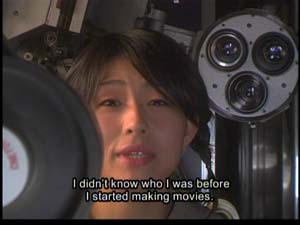
Offscreen: I assume that you haven’t had any of your films shown before in North America? And how do you see the future of The Way of the Director? Do you envisage it going to other film festivals? Is it your hope that it will get released? And because so many digital features are now being made, presumably this means it is even more difficult to get works such as your own shown, anywhere.
TM: One of my works (SABU, Goodbye to their Youth, 2000) was shown at Tromadance in 2002. Right now I am sending The Way of the Director around to other festivals, but, I haven’t heard anything yet.
Offscreen: I think that a distributor like Women Make Movies in New York City might be interested in a comic, feminist work on the world of independent film like The Way of the Director, and I’ll see what I can do to help…
TOMOKO MATSUNASHI filmography/videography:
1995 To Be or Not to Be, 8mm, colout, 28 min.
1996 Cherry Boys Legend, 8mm, colour, 55 min.
1997 Seventeen, VTR, colour, feature
1998 Bitch Matilda, VTR, colour, feature
2000 SABU: Goodbye to Their Youth, VTR, colour, feature
2002 Replicant Joe, VTR, colour, feature
2004 Teacher Emanuelle, VTR, colour, 33 min.
2005 Bitch Matilda 2, VTR, colour, 30 min.
2005 The Way of the Director, VTR, colour, feature



